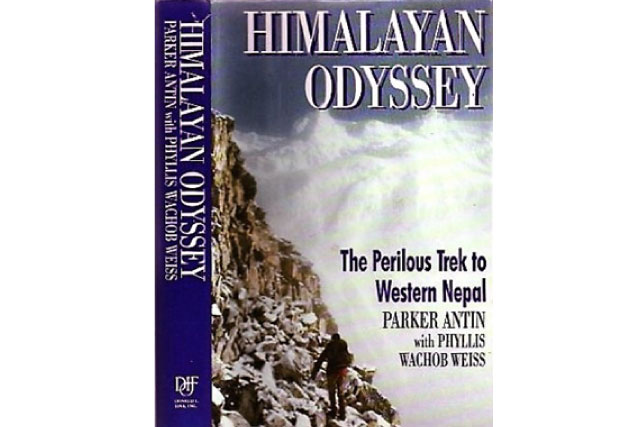"A good author should always suffer for his or her art. Well, the best travel writers suffer more than most, so perhaps that’s why their books are so memorable..." - AbeBooks.com

In 1984, as Nepal was experiencing an influx intrepid world travelers with lax control over where they went, or how, an adventurous but relatively inexperienced twenty-something year old American named Parker Antinhired some porters and set off on a high trek across west Nepal.
Hechronicled his trip in a well written but not well knownbook entitled ‘Himalayan Odyssey: The Perilous Trek to Western Nepal’ (1990). “This is a true story,” he says in the Acknowledgments, “presented with minor changes of some names and places?minor in that they camouflage the truth only when necessary to protect those with whom I shared these experiences.”
There’s no camouflaging Antin’s emotions in his story, as he discovers more about Nepal and himself than he anticipated. On a day late in March, along the trail to Dolpo’s Balangra Pass (3760m/12,336ft), he came upon “A young Tibetan woman, startling in her beauty” sitting beside the trail nursing a newborn baby –
“With half closed eyes, a smile of enchanting radiance lit her rosy-cheeked face as she turned it towards the warmth of the sun’s last rays. I stood mesmerized. Despite poverty, hunger, disease, ignorance, this woman-child who held life itself in her arms personified the quietly persistent will to live of these mountain people...”
A while later, while resting beside the forest trail, he saw one of the rarest of Himalayan animals, a red Panda, coming toward him unawares. “He leapt gracefully in undulating strides until barely thirty yards away...” And,“Rearing up slightly, he inspected me for several seconds with an odd, dancelike swaying motion, and then was gone, off the trail and out of sight.”
Experiences like these with Nepal’s rich culture and naturemoved Parker Antin. He sat there quietly for awhile longer, overcome bymelancholy, withmoist eyes, pondering what it all meant. That moment, and many like it on this trek, helped give Antin a new outlook on life.
Trekking in Nepal can have that sort of effect on you, but few writers describe it so well –
“The pull of the Himalayas for many is a religious quest, a search for enlightenment, personal fulfillment, a guru, the Way. Having scoffed at all that, I now began to understand, to feel the essence of life as I never had before. By coming halfway around the world, by removing myself in multiple cultural and physical layers from my upper-middle-class existence in America, I was beginning to learn a lesson in what it meant truly to live on this earth...”
That’s how this remarkable travelogue reads, with the author skillfully transportinghis readers along with him over some very high passes, through beautiful forests and meadows, across steep landslides andfast flowing rivers, and on.
The reader should also be prepared to find that good story is not all sunshine and cheer. Antin and his companions also suffered, “like the best travel writers... more than most”(as Abebooks has put it).On their way to begin theodyssey, with twelve hours to kill waiting for a bus in the Terai, they checked into “a filthy, windowless room in a filthy hotel...,” where theydiscovered bedbugs –
“As hardened Third World travelers, we thought we could handle a few bedbug bites. We were wrong. These unsavory mattresses crawled with the evil little beasties. Scratching and cursing, we tore the mosquito net down and wrapped ourselves in them. Unfortunately, tattered mosquito nets don’t stop bedbugs. We slept intermittently between the scratching.”
At four o’clock the next morning a bus horn blasted them awake. After a quick glass of tea and roti they stumbled through the dark to their bus, and continued uncomfortablytowardtheir epic trek.
The best travel writers go beyond vivid descriptions of their destinations... - AbeBooks.com
Postscript. Antin Parker stayed clear of check posts during his west Nepal odyssey. He didn’t have the required trekking permit. That feat is far more difficult today than it was in 1984, and it is definitely not recommended, ever, for a variety of reasons-not least, one’s own personal safety. In recent correspondence with Antin about the book, he commented: “I'm surprised to hear that anyone remembers it. I've heard you can get it for 98 cents on Amazon.com.” Look again, there are copies for sale there now for $0.01 (1¢), plus shipping. Now, that’s a real bargain, for Parker’s Himalayan Odyssey is a good trek-&-travel story.
‘Himalayan Odyssey: The Perilous Trek to Western Nepal’ by Parker Antin with P.W. Weiss (A Laurel Expedition Book, and Dutton Adult, 1990).
Don Messerschmidt is a corresponding editor to ECS Nepal. He can be contacted at don.editor@gmail.com.









